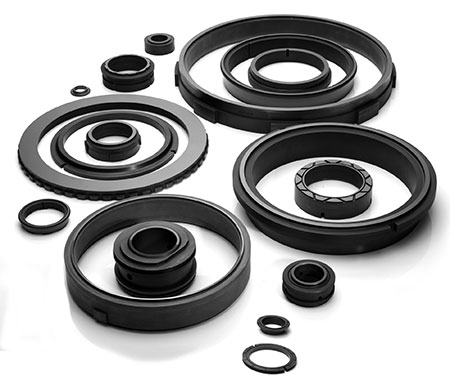
Most engineers are accustomed to hearing about the benefits of using carbon graphite and graphite in extreme applications like the oil and gas or aerospace industries, but carbon graphite can also be used in the food and pharmaceutical industries. These self-lubricating, oil-free materials are able to be used in mixers, conveyors, roasting ovens, vacuum pumps, mixer scraper blades and more.
The food and pharmaceutical industries are known for being highly regulated because the final product enters the human body. As such, there are material approvals that carbon/graphite passes that allow it to be a viable option for these industries.
Carbon graphite material grades vary due to impregnation (carbon, resin, copper, nickel, bronze, etc.). During manufacturing, the impregnation is used to fill available porosity of the part and add to the physical properties of the material grade. Some impregnations are able to fill all available porosity of the carbon/graphite base material better than others. When the porosity of a part is completely filled, the part is considered impervious to liquids. As a result, there is no available space for bacteria to enter and grow. Material grades that are impervious to liquids and do not contain substances that are prohibited by the Food and Drug Administration (FDA) are considered to be generally recognized as safe (GRAS).
In addition to being classified as GRAS, carbon/graphite material grades can also have approvals from the United States Pharmacopeial Convention (USP), National Sanitation Foundation (NSF) and Water Regulations Advisory Scheme (WRAS).
USP Class VI approval— the most stringent—is one of six designations tested for plastic and polymers used in medical applications where the product will come into contact with human tissue. It tests for toxicity of the part. NSF-51 approval focuses on material that comes into contact with food equipment during manufacturing, according to FDA regulations. NSF-61 focuses on materials that come in contact with drinking water following requirements by the U.S. Environmental Protection Agency (EPA) and Health Canada. Similar to NSF-61, WRAS approval focuses on materials that are in contact with drinking water for the United Kingdom.
Using these approved carbon graphite and graphite material grades ensures the safety and integrity of the final product because the material does not contaminate the manufacturing process or product. When these approvals are combined with the benefiting properties of carbon graphite and graphite parts, these materials can be used in the food and pharmaceutical industries in high temperatures, submerged applications and dry applications.
High Temperature
Carbon graphite mechanical components are able to work efficiently at temperatures up to 1,000 F in oxidizing environments.
At these temperatures, carbon/graphite’s self-lubricating properties are beneficial because they eliminate the need for traditional lubricants that would volatilize or carbonize. It also eliminates the need and added expense of food-grade and high-temperature lubricants that require separately installed lubrication systems. High temperatures can also result in high friction or high wear on traditional metallic rubbing parts that could result in seizing or galling.
Because carbon graphite and graphite mechanical components are self-lubricating, they will not seize or gall during use. In addition, carbon/graphite is dimensionally stable, so changes in temperature will not deform the part. Carbon graphite and graphite components are common in ovens, dryers and food conveyors.
Submerged
Carbon graphite and graphite material grades that are approved for use in food and pharmaceutical applications can run in direct contact with food. Carbon graphite’s self-lubricating properties are superior in these submerged applications because traditional and food-grade lubricants can dissolve or wash away. In addition, carbon graphite is an inert material, which makes it chemically resistant to many liquids, allowing it to successfully run in milk, beer, pharmaceuticals, soda and fruit juice—to name a few.
Dry Running
In addition to successfully running in dry applications without additional lubrication, special carbon graphite grades are available to successfully run in dry nitrogen or vacuum applications with low humidity. Nitrogen purges are common in pharmaceutical applications to cleanse pipes and tanks of contaminants. Nitrogen purging replaces an undesirable atmosphere with an atmosphere that is inert and dry. In these environments, special carbon graphite material grades are able to still provide the self-lubricating properties needed to run successfully while also having approvals for pharmaceutical applications.
The benefit of using carbon graphite and graphite mechanical components lies in the properties it offers the application to help minimize downtime and increase efficiency. Traditional metal components can fail if sufficient lubrication is not present, while polymeric seals can melt at high temperatures. These failures can result in costly repairs and additional downtime. Finding the correct food-grade or high-temperature lubricant can also be costly. Carbon graphite and graphite material grades have been tested to ensure that they are safe to use in food and pharmaceutical applications. These approved material grades can be beneficial to the application when used in the food and pharmaceutical industries.

